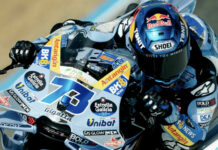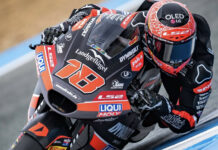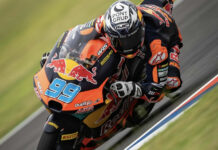Pirelli at Donington Park emphasises the new standard SC0 soft compound, encouraged by the results obtained at Monza The new 17-inch Diablo Superbike SC0 tyres could be the race solution for the rear in the event of high temperatures. Alternatively the riders will be able to count on various SC1 and SC2 blend solutions, as well as the intermediate and wet tyres Donington Park (United Kingdom), 20 May 2013 – Pirelli embarks on English soil armed with the results and satisfactions obtained in the first rounds of the eni FIM World Superbike Championship, but well aware that there is still plenty of season ahead full of challenges and problems. At Donington Park, the cradle of the World Superbike Championship since the very first round of the factory derivative championship was raced here in 1988, historically the weather has been the biggest unknown factor and, precisely for this reason, the tyre manufacturer from Milan will provide the riders with a vast choice of solutions that, in terms of compound hardness, covers the entire range available. Thanks to the experience gained throughout the years as sole supplier for the World Superbike Championship, but also in the British Superbike Championship, in addition to their standard tyres, Pirelli has developed some solutions for both the Superbike and Supersport class for the rear in a medium compound which, especially in cases of cold temperatures, could prove to be priceless for the teams and riders. On the other hand, in the event of pleasant weather, the riders will almost certainly choose the standard SC0 solution because it performs the best and is capable of providing the most grip. However, it is less protected from the cold and therefore more prone to cold tearing if used in temperatures which are too low. For the Superbike Championship, currently led by Aprilia rider Sylvain Guintoli (137 points) followed by team mate Eugene Laverty (124), Englishman Tom Sykes (119) on Kawasaki and Italian Marco Melandri (96) on BMW, the round could shuffle the deck further in the event of rain because the English riders know this track quite well and they are specialists in wet riding. The Donington Park circuit was built in 1931 specifically for motorcycle racing. During World War II activities were interrupted and the track was closed until 1971 when it was reopened by a local businessman who was a motor sports enthusiast. The track is 4,023 metres long with 7 right-hand turns and 5 left-handers. It runs clockwise and the pole position rider starts on the left. Maximum slope is 8% and the turn radii go from a minimum of 24 metres to a maximum of 333 metres. Donington Park is located in the Eastern Midlands 180 km north of London near Sherwood Forest and it was built in a natural amphitheatre that is quite conducive to watching the races for the spectators. It is a fairly fast track with a lot of uphills and downhills and some fast turns that require sharp braking and acceleration and put the riders to a hard test. The races are often held in the rain which makes the asphalt slick and slippery and that increases the riders’ efforts, at the same time highlighting their wet riding skills. Donington Park from a tyre point of view: The British Donington Park circuit is a mixed type track. It is partly made up of fast lines with various uphills and downhills (i.e. Holly Wood) and partly of slow turns with straight stretches in between which require sharp braking and acceleration such as the Melbourne Hairpin (turn 10). Then, on the straight stretch coming out of the Coppice (turn 8) the highest acceleration coming out of a turn is reached. But the most interesting elements of the circuit are the two medium turns that break up the straight stretch opposite the finish (Old Hairpin and McLeans Corner). The turns are at the same time abrupt like a chicane but fast like a long turn, with the bikes never dropping below 100 kph. The rider can make up significant time increasing minimum speeds along the kerb and by navigating these two turns expertly can result in earning precious tenths of a second. If compared to other tracks, Donington Park is a circuit where extremely fast speeds are not reached. The maximum speed is just above 260 kph and the average speed is about 160 kph. This is an abyssal difference compared to the 340 kph at Monza or the 320 kph at Phillip Island, with average speeds of 200 kph or 180 kph. Combined with the typical local weather conditions, this translates into an extremely cold operating temperature for the tyres: in fact, the surface temperature oscillates from a maximum of 110°C to an extremely low minimum of 50°C. The Diablo Superbike tyres must bring out their maximum flexibility, guaranteeing the usual 55° lean angle and the usual lateral and combined accelerations of 1.4 Gs, despite the fact that the operating temperature will be the same as normal street use. Especially in the first part of the circuit great stability is required for the front end. Consequently the main goal of the front tyre must be to hold its conformation as much as possible and to guarantee the support needed to manage downhill turns. Particularly when hot, where the elasticity and rigidity of the tyre decrease, the use of a rigid front tyre may prove to be necessary such as, for example, the SC1 S41 and SC2 R982 solutions. On the other hand, the rear tyres are affected mainly by the sharp and violent acceleration phases which are typical of the track, especially coming out of the Coppice. In cold weather conditions the tread compound, especially the softer ones, struggles to reach proper operating temperatures and, because of the high rigidity properties, risks suffering lacerations and surface tears in acceleration. In these cases it is advisable to use more mechanically robust solutions on the rear such as the SC1 R831 or the SC2 R1300. Wear from tearing tends to decrease greatly with high temperatures. On the other hand, however, in these conditions the track generally provides very poor grip. Therefore, in order to guarantee more precise lines, the riders can resort to using softer solutions such as the SC0 R1261 or the SC1 R828, better able to penetrate the road surface and to guarantee correct traction. Donington Park from a technical point of view: “In past seasons we raced at different times of the year on this track, such as March, September and then May” remembers the Pirelli Moto Racing Director, Giorgio Barbier “In the late ’80s, specifically in 1989, we were even welcomed by 4°C and a beautiful snowfall! From that time on we have always tried to move this round toward the warmest season and this is one of the reasons the races here will be at the end of May this year. Despite this, in terms of weather and, more specifically in terms of temperature, Donington is always an unknown. There could be springtime conditions with pleasant temperature which would allow even soft compounds like the SC0 to be used, or there could be particularly cold and even rainy days where riders are forced to use intermediate or wet tyres with more protection instead of the slicks in order to prevent the tearing and excessive wear caused by the cold. This is why we typically try to bring a vast choice of solutions and alternatives to this round. If the weather is hot or in any case the temperatures are pleasant, then most of the riders will most likely use the SC0 rear solution, the softest in the range and also the one which able to provide the best grip. Otherwise, if it is cold, we will be ready to provide them tyres such as the SC1 and SC2 solutions, with slightly lower performance in terms of grip, but which would allow them to ride excellent races in any case. Then, if by some unfortunate chance there is rain, we will have the wet tyre available as well as the new intermediate which the riders have not yet had the chance to test”. Pirelli solutions for the Superbike and Supersport classes: Pirelli will be bringing 3768 tyres to Donington for the fifth round of the eni FIM World Superbike Championship. The reason for this quantity, less than what is usually brought to other European races, is that only the Superbike and Supersport classes will be competing at the English circuit. Specifically, compared to the total number of tyres brought by Pirelli, 1740 will be reserved for the Superbike class and 2028 will be for Supersport. Each Superbike rider will have 36 front and 40 rear tyres to choose from, whereas the Supersport riders will have 25 front and 27 rear tyres. In detail, for the Superbike class the manufacturer with the long P will bring 3 different slick solutions for the front and 4 for the rear, in addition to a quantity of 2 per rider of the rear qualifier and the intermediate solutions, with 4 available for the front and as many for the rear, as well as 8 wet tyres for the front and 8 for the rear. The choice of slicks for the front anticipates two SC1 soft compound solutions and a medium compound SC2. In fact, both the standard SC1 and SC2 will be present (respectively the specific R426 and R982 versions) which have so far been brought and used with excellent results to all the rounds raced this year, as well as the S41 development SC1 which was already seen at Aragón and Assen as an alternative to the standard SC1 and designed for the purpose of guaranteeing greater mechanical stability. The latter solution will be a good compromise between the SC2, which provides solidity, and the SC1 in terms of grip. On the rear included in the dry solutions will be the new standard SC0 soft solution (R1261), making its début, although in all actuality, albeit with a reinforced central compound, it already demonstrated its characteristics at Monza where it was used by all the riders on the grid, allowing Melandri and Sykes to break historic records. The SC0 is ideal to tackle smooth asphalt and high temperatures because it provides maximum contact area on smooth asphalt and maximum traction development at high temperatures, in addition to its greater performance stability under thermal decline. However, if temperatures are not high enough, the riders will be able to count on another three alternatives: the standard SC1 (R828), which, by its very nature, is the most versatile solution and the one that best adapts to different tracks and temperatures, a new SC1 development solution (R831) as an alternative to the standard SC1, capable of ensuring better grip compared to the SC2 and more robustness with respect to the SC1 and, to complete the range of choices available to the riders, the R1300 SC2 medium-hard compound solution, which Pirelli only brought to Phillip Island and which should provide greater resistance to wear than the standard SC1 because it is more protected, but at the same time more grip than the standard SC2. For Superpole on Saturday a super soft tyre will be available as always in order to allow the riders to obtain the best possible times for grid placement. For the front the Supersport riders will be able to choose from the two standard solutions, the SC1 soft compound (P1177) and the SC2 medium (R1031), already used and brought to all the races so far in 2013. In the Supersport class as well, for the rear the riders will be able to choose the new standard SC0 (R1557) and standard SC1 in medium compound, the R303, already brought to the first four rounds of the championship. New and making its début will be the R1442 solution, a development solution that falls midway between the SC0 and the SC1 in terms of compound hardness, providing mileage similar to that of the SC1 but with greater grip, as well as being better protected against the cold than the SC0. The 2012 Pirelli statistics for Donington Park: • Total number of tyres Pirelli brought: 3712 • Number of solutions (dry, intermediate, wet and qualifier only for rear) for the Superbike class: 5 front and 7 rear • Number of solutions for the Supersport class (dry, intermediate and wet): 4 front and 5 rear Number of tyres available for each Superbike rider: 35 front and 40 rear • Number of tyres available for each Supersport rider: 24 front and 28 rear • Superbike Best Lap Awards won both by Max Biaggi (Aprilia Racing Team) in 1’28.992 (Race 1, 6th lap) and in 1’28.995 (Race 2, 4th lap) • Supersport Best Lap Awards won by: Sam Lowes (Bogdanka PTR Honda) in 1’31.097 (21st lap) • Temperature in Race 1: air 17° C, asphalt 31° C • Temperature in Race 2: air 18° C, asphalt 31° C • Maximum race speed reached by Pirelli tyres: 274,4 km/h, Max Biaggi (Aprilia Racing Team) in Race 1 on the 19th lap.
eni FIM Superbike World Championship: Pirelli Talks Tires And Donington Park
eni FIM Superbike World Championship: Pirelli Talks Tires And Donington Park
© 2013, Roadracing World Publishing, Inc.






